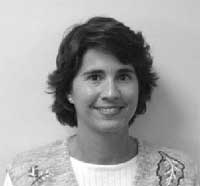
Promoting Cooperation to Maintain
and Enhance
Environmental Quality in the Gulf of Maine
Winter 2001
|
About |
|
Regular columns |
|
Archives |
Q&A with Priscilla Geigis
By Maureen Kelly
 Priscilla
Geigis. Photo courtesy of Priscilla Geigis
Priscilla
Geigis. Photo courtesy of Priscilla Geigis
In September 2000, Governor Paul Cellucci (now U.S. ambassador to Canada) and Lt. Governor Jane Swift (now acting governor) signed the Community Preservation Act into law in Massachusetts. The legislation resulted from a 15-year effort on the part of Secretary of Environmental Affairs Robert Durand, who first sponsored the legislation when he was a state senator. Priscilla Geigis, the director of Community Preservation for the Executive Office of Environmental Affairs, recently explained how the act will help Bay State communities manage development and preserve open space. The following is an excerpt from that conversation.
How does the act manage sprawl?
The Community Preservation Act is designed to address communities’ needs as they continue to grow, as they develop plans for the future. We’ve been going around to all 351 communities in the Commonwealth and helping them look into their future by providing them with GIS-based maps and analyses to show them what their growth patterns are. And then, to show them a build-out scenario, that shows their community at maximum build-out—if every piece of land that could be developed were developed based on the existing zoning and existing state regulations.
The Community Preservation Act helps people preserve what’s important to them and to make sure they maintain their community character. It does that by having the communities establish a local fund through a surcharge on their local property tax of up to three percent. The money that is accumulated from that surcharge will be solely dedicated to community preservation. That means that it needs to be spent on historic preservation, open space and community housing (low and moderate income). In terms of combating sprawl, it provides the financial resources to communities to enable them to protect what’s important to them.
How does the act encourage communities to work together towards common planning goals?
We did Super Summits in five regions across the state where we took 12 to 51 communities depending on the region and showed them not only their build-out map but a composite build-out map for the region, so they could see what was in store for their neighbors. It was really trying to spur discussion and encourage communities to work together.
One of the key components of the Community Preservation Act is that money that is collected locally can be spent anywhere in the Commonwealth. So, you could have communities pooling their money together and working on a rail trail or a bike trail or an intercommunity park or protecting a water supply that may supply water to a variety of communities.
Do you think the act will help coastal communities in any particular way?
Yes, I definitely do. There’s a provision in the act that says open space can include land to protect future and existing well fields, aquifers, recharge areas, watershed land, agricultural land and it specifically mentions salt-water marshes, ocean, river frontage, beaches, dunes and other coastal lands.
What is the process that a community goes through to enact the act?
The act has to be put on their ballot. It can get on the ballot one of two ways: it can be voted on by the local governing body—the town meeting or city council. If there is a failure of that body to vote, or a vote not to put the act before the voters, a community can also go the route of a petition process. Five percent of the registered voters would need to sign the petition for it to be put on the ballot.
How is the money distributed?
Communities would get a match based on how much money they’ve collected and what the surcharge is. That money would go into the local fund. In addition, the state has a match that it will distribute once a year in October. There are surcharges on some transaction recording fees at the Registry of Deeds that are being collected and put into this big state match.
It’s anticipated that the state match will be about $26 million each year that it’s distributed. The first year of October 2002 it’s going to be larger, probably $39 million, because the fees will have been collected for 18 months.
What would you say to those who baulk at a tax increase?
To communities that say, “We can’t afford this,” what I would ask them is, “Can you afford not to pass this?” The whole Community Preservation Initiative’s basis is to provide tools to communities to help them make informed decisions. The Community Preservation Act is one of the most important tools that communities can have to help them make decisions when they grow.
For more information visit the Community Preservation Act’s home page: www.state.ma.us/envir/cpa/communitypreservation.htm